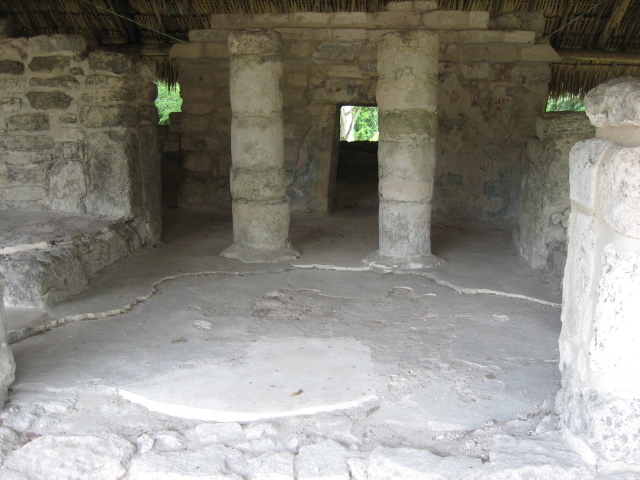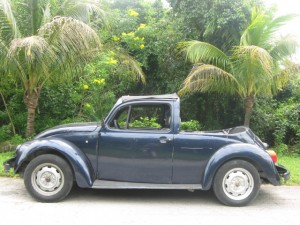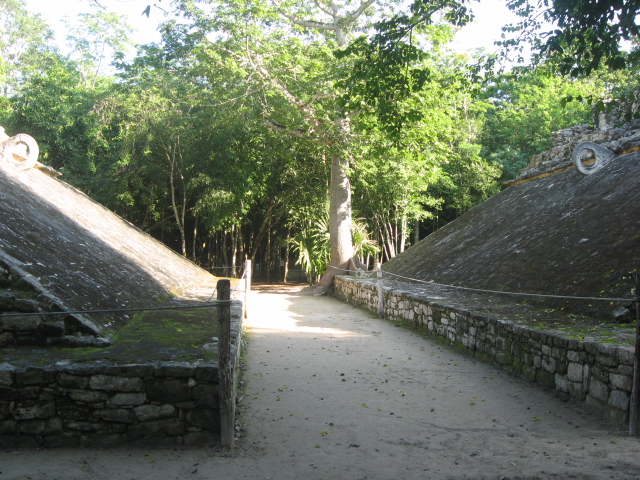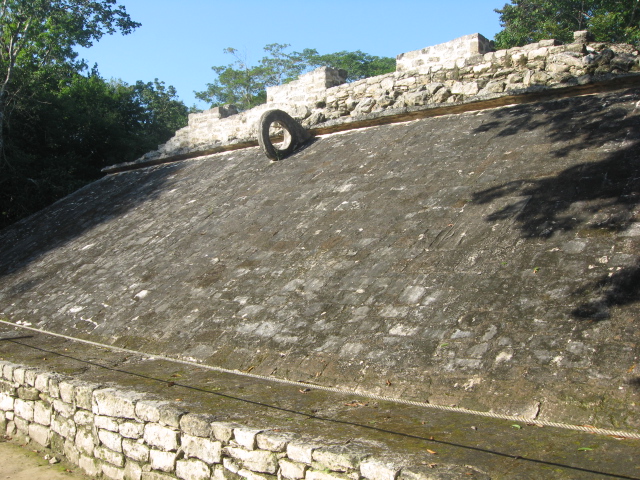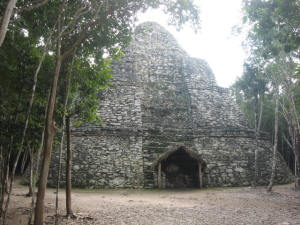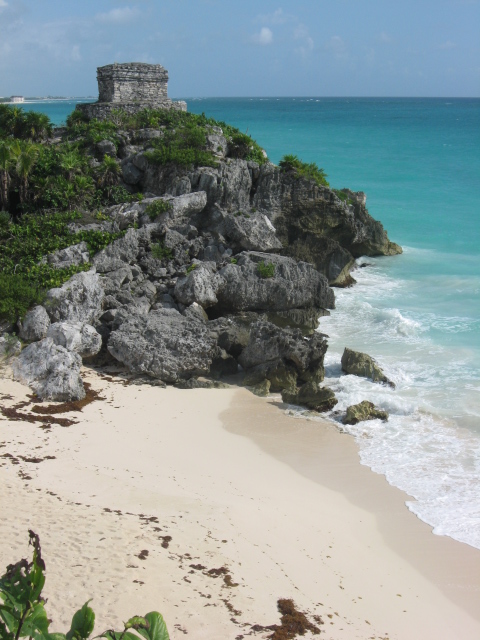
Ruta Maya – Part Three
This is Part Three of a series of articles about Central America’s Aztec and Mayan pyramids and ruins. Updated Sep 2022.
Cancun
After touring Teotihuacan, you will need to make your way from Mexico City, by air, bus or car, to Cancun in the Yucatan Peninsula.
Take a day or two to be a typical tourist in this beautiful part of Mexico. The beaches are fabulous. The hotels on the beach, however, are very expensive. You can get a decent hotel in the city, near the bus station, for about $40. The city hotels are not fancy but are clean and safe. You can take a bus or taxi to the beach.
El Rey
While in Cancun, check out the ruins at El Rey (the king), in the hotel zone, near the beach. El Rey is small and has no pyramids or other large structures, but it is still worth the visit if you have the time. One highlight of my visit to El Rey was not the ruins but the many iguanas and tropical birds that inhabit the site and were relatively tame.
San Gervasio, Isla Cozumel
From Cancun, make your way to the island of Cozumel. Isla Cozumel is dotted with Mayan ruins. Unfortunately, most of them have been destroyed by many hurricanes since they were abandoned in the 1500s. The only one that is worth visiting is San Gervasio. The photo on the right above shows the original Mayan road and the gate into the city.
Transportation on Isla Cozumel
We travelled from Cancun by bus and then by ferry to the island. Cozumel is Mexico’s largest island. There are no buses. The only way to get around the island is to take a taxi or rent a car or scooter. I rented a beat-up old Volkswagen beetle with half the top missing. It was only $35 per day with unlimited kilometres plus $10 for optional insurance, which I would not go without. I checked into going places by taxi and found that renting a car was cheaper and much more convenient.
The ruins were interesting, but there are many more impressive ones on the mainland. Although Isla Cozumel is not the best place for Mayan Ruins, it is worth a visit as it is a lovely place to relax and enjoy the Mexican sunshine and good food.
Tulum
Back on the mainland, we travelled south, by bus, along the coast to Tulum. It was once a large Mayan city called Zama. The city is surrounded on three sides by a great wall. The wall is three metres tall and six metres thick and has five gates (one of them in the photo above). The gates are very small, and people can enter only in a single file. Therefore, it would be impossible for a large group of people to attack through these gates. There are lookout towers on the two corners to watch for attacking forces. The Caribbean sea is on the fourth side, and there is a large cliff.
Today the houses and less significant buildings are gone. But the larger buildings are still standing after almost 1,000 years. The city reached its peak in the years 1250 to 1550. It was one of the last Mayan cities to be abandoned. The Spanish captured it in 1544. When the buildings were new, they were covered in stucco and painted and decorated. Some of the buildings have faces carved into the corners. Even the streets were paved with stones and stuccoed. It must have been a beautiful place in its time.
The Temple at Tulum
The most important building in the city was a large temple that was built on the very edge of the cliff. There is a nice beach where you can go for a refreshing dip in the sea if the weather is good.
We went to the ruins early and were there when it opened at 8 a.m. There were only about 20 people in the city, so I could photograph the buildings without crowds of people in the picture. By the time we left at 10 a.m., there must have been more than 2,000 tourists in the city and more arriving by the busload every minute. There were tour groups in English, Spanish, German, French, Japanese and other languages. While the thousands of other tourists were in the city, we returned to our air-conditioned hotel room.
The Mayan Riviera
The coast from Cancun to Tulum is mostly one large tourist zone called the Mayan Riviera. Large hotels and other tourist businesses are everywhere. Fifty years ago, Cancun, Isla Cozumel, and other towns along the coast were just little fishing villages. Now, most people earn their living in the tourist industry. There are probably about 200,000 tourists along the Mayan Riviera during the tourist season, which starts about the first of December. I have met people from Brazil, Canada, the USA, the Czech Republic, England, France, Germany and many other countries. The area is extremely safe. I have not heard of a single robbery or any other crime involving tourists since I came here. The Yucatan peninsula and the Baja peninsula are the two safest places in Mexico.
Travel to Coba
Next, we went to Coba, which is another Mayan city. Coba is about 50 km from Tulum. The site opens at 8 a.m., but the first bus from Tulum does not go until 9 a.m., so we went in a “colectivo”. A colectivo is a van or minibus of various sizes that travels up and down the road, “collecting” and dropping off passengers. They have a few designated stops, but mostly you flag them down in the street, and if they are not full, they will stop for you. Being at their official stops early will ensure a seat. They are much cheaper than taxis. Ask around where to find the colectivos.
We got to Coba at about 8 a.m., and we had the place mostly to ourselves with a few other people until busloads of tourists arrived at about 10:30. We found this is the best way to see any of the ruins. The early bird gets the place to themselves before the crowds arrive.
Coba
Coba is in the forest and covers a huge area of almost 70 square kilometres. The buildings are in groups, and the groups are one or two kilometres apart. The structures here are not as well preserved as those at Tulum. Many of the structures are getting overgrown with trees. The roots of the trees damage the buildings. In some places, trees are growing right out of the stairways.
It was perhaps the largest of the Mayan cities. It was at its peak, about 600 to 800 AD. Coba was one of the most important Mayan cities, but it mysteriously lost its power to Tulum and other places. When the Spanish arrived in the 1500s, they found the city abandoned. Many nearby structures have yet to be excavated. Experts estimate that as many as 6,500 ruins are still unexcavated in the forest. After centuries of neglect, these structures look like large hills. We saw one of them. The Mexican government spends a lot of money on maintenance at the more popular sites of Tulum and Chichen Itza but not very much money is designated for Coba.
Ancient Mayan Roads

Many people rent bicycles or take a three-wheel bicycle taxi to get around the site. I wanted to walk as it is good exercise, allowing me to look for birds and other critters along the way. New roads have been built for this purpose, but if you look carefully, you can still see the old Mayan roads that are now overgrown with trees. The roads were built above the forest floor to remain dry during the rainy season (photo on the left). Mayan roads were built between cities, and one could travel from Coba to Tulum or Chichen Itza, which is more than 100 km away. Runners were posted every five kilometres along the road to deliver messages between cities quickly. One of the modern roads crossed the old Mayan road, but most people went by without noticing it.
Pyramids at Coba
There are two pyramids, one 28 metres tall and the other 42 metres tall. The smaller one is mostly in ruins and is not climbable. The larger one is in better condition. People do climb up it, but the steps are very steep. Coming down is dangerous. Several tourists have lost their step and tumbled down the pyramid to their death. The safest way to get down is on your bum, sitting on each step as you descend. We saw several people coming down using this method. Besides being dangerous, it was hot and looked like a lot of work. So we didn’t climb it.
Ball Courts
The Mayans and Aztecs played a game similar to soccer in that the players could not use their hands. However, unlike soccer, the goals were a circle with holes high up on the slanted sides of the court instead of at the ends of a flat court. It must have been challenging to score a goal. The ball would have to go up the slanted sides of the court at an angle that would put it through the goal, which was a small circle. Players would be on the sloping sides and in the centre court, so perhaps one player kicked it up, and a different player would kick it toward the goal. The flat centre of the court was not very big.
There are several legends concerning ball games. One legend is that the players fought for the honour of being sacrificed to the gods. Another legend has it that the losers were killed. No one knows for sure. I have seen these ball courts before in Aztec cities further north. Although the Aztecs and Mayans had different cultures, they played the same ball game. I wonder if they ever had competitions like the Olympics. Coba has two ball courts, which shows the game’s popularity and the city’s importance.
The Beehive
The Mayans liked honey, and pictures of their honeybee god were carved into some stones. There is one building that is in the shape of a beehive.
While walking between structures, we searched for birds and other wildlife. There are supposed to be a lot of tropical birds here, including toucans, but we didn’t see any. We saw a large termite nest in a tree, some tiny frogs and a colourful beetle.
Army Ants
We happened to see a swarm of army ants on the march. This is one of the most interesting things I have seen in a long time. I have seen it on National Geographic on television. I knew they were here, and it was one of the things I wanted to see on this trip. Some people stopped to watch them, and others hurried past to get away from them. Army ants are tiny but travel in huge swarms consisting of millions of individual ants. Anything that gets in their path is in big trouble. These little ants attack and kill much larger animals, such as scorpions. We saw an unfortunate beetle and a large spider that fell prey to the ants. The ants attack them in such numbers that they don’t stand a chance of getting away. They will even attack people if you get too close and stand still. I wanted to get close enough to get a little movie, and they soon attacked my shoe. Laura and I were intrigued by them and stayed to watch them for a long time. Keep a look out for them on your tour of Coba.
For an article on Army Ants, click here.
Getting back to Town
After touring the ruins, we found that the next bus to Tulum would be another hour and a half. You never know when a colectivo might come along. There might be one in five minutes, or it could be an hour. I decided to hang around the taxi stand and look for other people that might want to share the cost of a taxi. We found a couple from California that wanted to go and negotiated an acceptable price for the four of us. When taking a taxi for long distances, try to find other tourists to go with you to share the cost. Always decide upon a price before you enter the taxi. After you get to your destination, it is too late to negotiate the price.
Tulum and Coba are very interesting and are essential stops on the Ruta Maya. One of the better locations will be our next stop – Chichen Itza.
For other parts on the series of Ruta Maya, click here.
